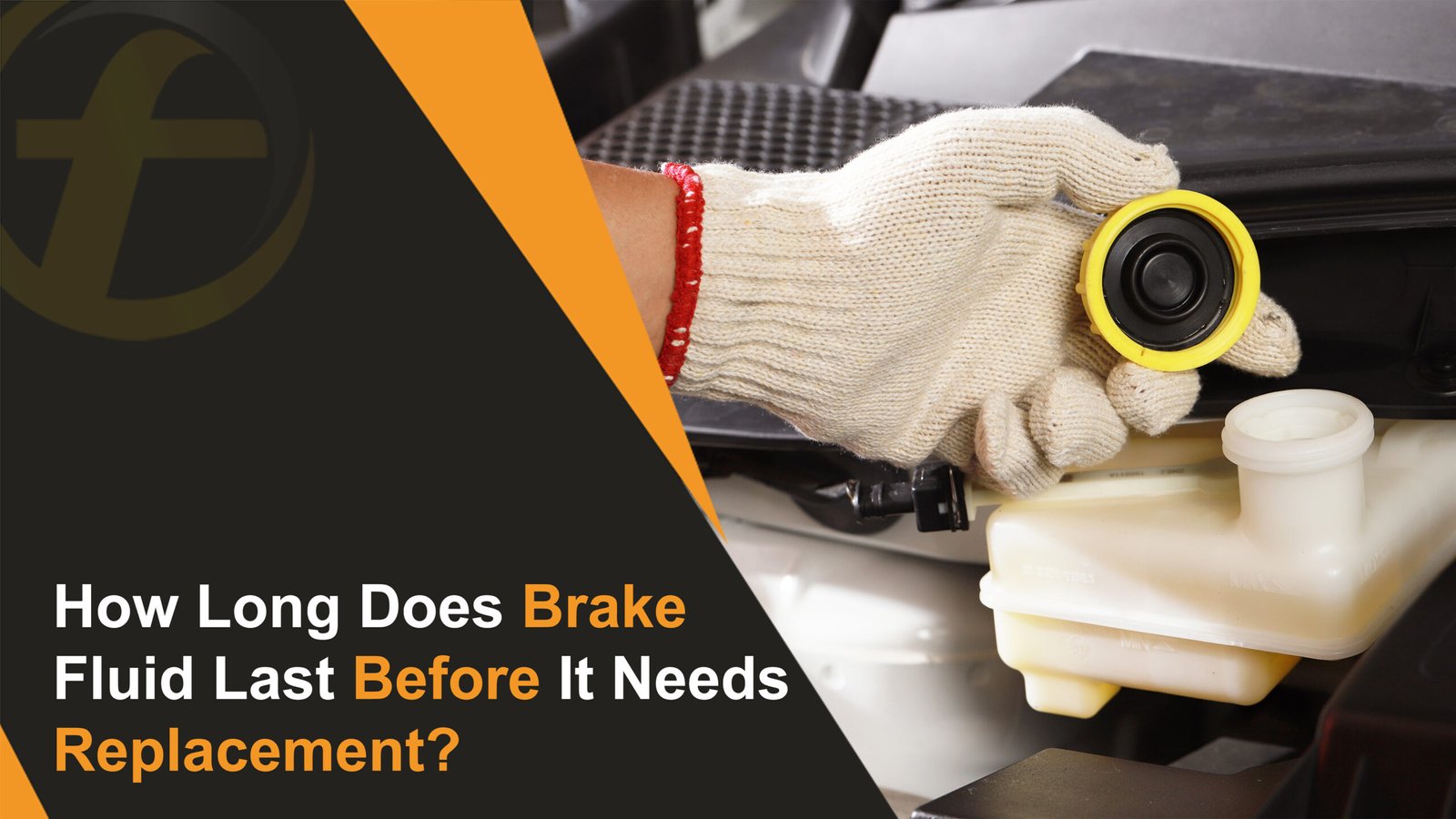
As a driver, you count on your brakes to keep you safe. But did you know it’s the brake fluid that makes your brakes work properly? This special fluid helps your car slow down or stop quickly when you press the brake pedal.
Like other parts of your car, brake fluid doesn’t last forever. Over time, it can get dirty or lose strength, which puts your safety at risk. So, how can you tell when it’s time to replace it? At Fubex Lubricants, we offer high-quality brake fluids for all types of engines. Enjoy fast shipping, a price match guarantee, and no-questions-asked returns. Need help choosing the right oil? Call us at +971 50 544 9614 — our friendly team is ready to assist!
In this blog, we’ll explain why brake fluid maintenance is so important. We’ll also share the key warning signs that show it’s time for a change. With this knowledge, you’ll be ready to keep your brakes strong and your passengers safe on every trip.
What You Need to Know About Brake Fluid
Your car’s brakes are hydraulic, which means they use a liquid called brake fluid to work. When you press the brake pedal, the fluid transfers that force into pressure, pushing it to the brakes on each wheel so your car can stop.
Liquids, unlike air, can’t be compressed. This makes brake fluid perfect for stopping power. That’s why almost all vehicles—cars, trucks, motorcycles, and even some bicycles—use it for better safety and control.
However, brake fluid doesn’t last forever. Over time, it can get dirty or run low, which can lead to brake failure. That’s why it’s important to check your brake fluid regularly and replace it when needed.
Why Do You Need To Flush And Replace Brake Fluid?
Brake fluid is special because it pulls in moisture from the air. When it gets too much water, it can rust parts inside the brake system and lower the fluid’s boiling point. Since brakes create a lot of heat, the fluid needs to stay strong and not turn into vapor.
Over time, heat and moisture make the fluid weaker, which can reduce how well your brakes work. That’s why it’s recommended to flush and replace your brake fluid every 2–3 years using fresh, high-quality brake fluid.
What Happens If Brake Fluid Is Never Changed?
Imagine driving on the highway and your brakes don’t work—that’s the risk if brake fluid is never changed. Over time, brake fluid absorbs water. This lowers its boiling point, causes rust inside the brake lines, and can even make them fail.
When brakes get really hot, old fluid can boil and turn into vapor. This creates something called brake fade, where your brakes lose power and can’t stop the car properly.
How Long Can You Go Without A Brake Fluid Change?
Brake fluid usually lasts about 2–3 years in most cars. To stay safe, it’s recommended to replace it every 2 years. If you take your car for regular service each year, your mechanic can check your brakes and let you know if the fluid needs to be changed.
Also Read: Can You Use Brake Fluid For Power Steering Fluid?
8 Signs of Old Brake Fluid You Shouldn’t Ignore
Watching for these signs is important to keep your brakes working well and to stay safe on the road.
- Brake warning light – Many cars have a warning light on the dashboard. If it turns on, it could mean low brake fluid or a problem with fluid pressure.
- Soft or spongy pedal – If your brake pedal feels soft or sinks too far before the brakes work, there may be air in the brake lines or weak brake fluid.
- Hard pedal – If the brake pedal feels too stiff, it could be from a brake booster issue, a blockage, or dirty brake fluid.
- Strange noises – Squealing, grinding, or other odd sounds while braking can point to worn parts or fluid problems.
- Leaking fluid – Any fluid around the wheels or under the pedal could mean a brake fluid leak, which lowers fluid levels.
- Weak braking power – If your car takes longer to stop or feels less responsive, the brake fluid may be old or contaminated.
- Dirty fluid – Fresh brake fluid is clear or light yellow. If it looks dark or dirty in the reservoir, it needs replacing.
- Car pulls to one side – If your vehicle shifts to one side when braking, it might be uneven fluid flow or another brake issue.
If you notice any of these symptoms, it’s recommended to get your brakes checked and the fluid replaced.
How to Change Brake Fluid
While it’s always recommended to let a professional handle this job, you can change your brake fluid yourself if you’re confident and careful. The exact process may vary depending on your car’s make and model, but here are the basic steps.
If you’re not familiar with your brake system, it’s safest to have a qualified technician do the work.
What You’ll Need
- New brake fluid (check your vehicle’s manual for the right type and amount)
- A wrench that fits your bleeder valves
- A brake bleeder kit or a clear tube and bottle
- A friend to help (for manual bleeding)
- Safety gloves and glasses
- A clean rag
Step 1: Prepare Your Vehicle
- Park your car on a flat, stable surface.
- Put the car in “Park” (automatic) or in gear (manual) and apply the parking brake.
- Open the hood and find the brake fluid reservoir on the master cylinder.
- Clean around the cap so dirt doesn’t fall inside when you open it.
Step 2: Check the Fluid
- Look at the brake fluid’s color and level. If it looks dark or dirty, it needs changing.
- Wipe the reservoir and cap with a clean rag before starting.
Step 3: Drain Old Fluid
- Start with the brake farthest from the master cylinder (usually rear passenger side). Then move to the rear driver’s side, front passenger side, and finally front driver’s side.
- Attach the clear tube to the bleeder valve and place the other end in a collection bottle with a little brake fluid in it (to stop air from going back).
- Use the wrench to slightly open the bleeder valve.
- Ask your helper to press and hold the brake pedal slowly. Old fluid and air bubbles will flow into the bottle.
- Close the valve before your helper lets go of the pedal to prevent air from re-entering.
Step 4: Flush with New Fluid
- Add fresh brake fluid to the reservoir.
- Repeat the draining process until you see clean fluid with no bubbles.
- Keep checking the reservoir and refill as needed so it doesn’t run dry.
- Do this for each wheel, moving closer to the master cylinder each time.
Step 5: Final Checks
- Refill the reservoir to the proper level (between “MIN” and “MAX”).
- Pump the brake pedal—it should feel firm, not soft or spongy. If it feels spongy, repeat the bleeding process.
- Dispose of old brake fluid safely—it’s hazardous and should not be poured down drains or into the trash.
Step 6: Safety Check
- Make sure no tools or materials are left around the car.
- Start the vehicle and test the brakes at low speed in a safe area. The brakes should respond properly.
Safety Tips
- Always wear gloves and safety glasses.
- Work in a well-ventilated area.
- Never reuse old brake fluid.
- Always use the exact type of brake fluid recommended in your car’s manual.
Why is Brake Fluid Important?
Brake fluid is what makes your car’s brakes work. When you press the brake pedal, the master cylinder pushes the fluid through the brake lines to the calipers. The calipers then squeeze the brake pads against the rotors, creating friction that slows down your car.
For this process to work safely, the brake fluid has to stay strong. It needs the right thickness (viscosity) and a high boiling point so it won’t turn into vapor when things heat up. But over time, moisture can sneak into the system, lowering the fluid’s strength and even causing rust inside the brake parts.
That’s why brake fluid isn’t just important—it’s critical for your car’s safety and performance.
Final Takeaways
Keeping your brake fluid fresh is one of the simplest yet most important steps to stay safe on the road. By paying attention to signs of old fluid and replacing it on time, you protect your car’s braking power and your peace of mind. At Fubex Lubricants, we recommend always choosing high-quality brake fluid to ensure smooth, reliable performance every time you hit the brakes.
FAQs
Q1: Which brake fluid is best for my car: DOT 3, DOT 4, or DOT 5?
The best brake fluid is what your car maker recommends—check your manual or cap. DOT 3 is for everyday driving, DOT 4 for heavy loads, and DOT 5 only if your car needs it.
Q2: What’s the difference between brake fluid and hydraulic fluid?
Brake fluid is a special liquid made to handle high heat and work with car brakes. Hydraulic fluid is a general liquid used in many machines. The big difference is that brake fluid has a higher boiling point so brakes don’t fail when they get really hot.

Editor-at-Large
A passionate writer in the lubricant industry, Awais Iqbal has been covering oils, greases, and industrial fluids since the start of his career. At 25, he’s already written for blogs, catalogs, and brand guides across the UAE. Awais’s insights help companies connect with their audience, and his clear, helpful writing style is trusted by brands in the region.


